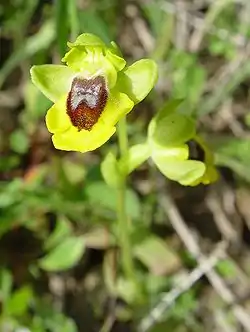Ophrys lutea
Ophrys lutea, the yellow bee-orchid, is a species of orchid native to southern Europe, North Africa, and the Middle East, the range extending from Portugal and Morocco to Syria.[1][2]
| Ophrys lutea | |
|---|---|
 | |
| Scientific classification | |
| Kingdom: | Plantae |
| Clade: | Tracheophytes |
| Clade: | Angiosperms |
| Clade: | Monocots |
| Order: | Asparagales |
| Family: | Orchidaceae |
| Subfamily: | Orchidoideae |
| Genus: | Ophrys |
| Species: | O. lutea |
| Binomial name | |
| Ophrys lutea | |
| Synonyms[1] | |
Description of the flower
Broad asymmetric lateral sepals, dorsal sepal lowered.
Extended petals, yellow or with a blue-grey or brown spotted velvety macula. Pollinated by male Andrena bees. This species is notable among Ophrys for the fact that the pollinating bees sit on the labellum facing away from the pollinaria instead of facing towards them, and thus collect the pollinaria with their abdomen.
Subspecies
Numerous subspecific names have been proposed, but as of May 2014 the following are accepted:[1]
- Ophrys lutea subsp. aspea (Devillers-Tersch. & Devillers) Faurh. - Tunisia, Libya
- Ophrys lutea subsp. galilaea (H.Fleischm. & Bornm.) Soó - from Portugal and Morocco to Syria
- Ophrys lutea subsp. lutea - from Portugal and Morocco to Turkey
- Ophrys lutea subsp. melena Renz - Greece, Albania
- Ophrys lutea subsp. sicula (Tineo 1817) - Italy
Flowering period
March to May
Habitat
The orchid grows in full sun or shade on limey dry or damp soils, pastures, and thin woodland.

from the French Wikipedia; technical translation of some words still needing checking